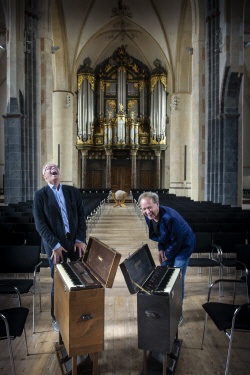Bach Cantatas volume II
<
This is a follow-up recording to a previous CD by the brothers de Jong featuring their own transcriptions of Bach cantata movements for organ duet. The previous CD had been recorded on the Hinsz organ at Bolsward. The current release features the 1727 Christiaan Müller organ in the Grote Kerk of Leeuwaarden. This was the first large instrument by the builder who would later go on to build the organ of the St Bavo in Haarlem, perhaps the most famous organ in the world. The Leeuwaarden organ however escaped a ‘restoration’ of the sort the Haarlem organ received in the early 1960s and is, therefore, much better preserved, retaining its enormously intense principals and reeds. It sounds excellent here, its choice being surprisingly effective for this instrumental music. This is especially the case when one considers the nature of such an instrument which is geared almost exclusively to the accompaniment of congregational singing.
I am a little sceptical about the organ duet genre in general. Too often, both in concert and on disc I have been too aware of the effort taken to overcome the synchronisation of hands and feet, resulting in mechanical music-making which seems to prove little other than that organists can indeed play duets. That, I am happy to report, is certainly not the case here. The music-making is, for the most part, natural and unforced, crucially with a very present sense of the role of the basso continuo from the secondo player. The only tracks which don’t entirely convince are the slowest. 'Ich habe genug' especially seems too static, with too many accents on the smallest note values somewhat compromising the natural flow. Klaus Mehrtens would struggle to keep going I fear. The registrational recipe on the other hand is delicious, the Dulciaan of the Bovenwerk providing the obbligato, while the Rugwerk Praestant 8’ (plus tremulant) provides the ‘Klaus’. This is typical of the colourful and sensitive use of the organ found throughout the disc, and all registrations are listed in the booklet.
By contrast the booklet is in general something of a let-down, lacking any personal input from the performers - something about their approach to the project and motivation for it seems essential - and featuring a rather amateurish English text. The specification of the organ also fails to tell us the sources of the stops; not everything is from 1727 of course.
But, overall, this is different, very well done, performed on a really first-rate instrument and is thus very enjoyable and recommendable.
Chris Bragg (www.musicweb-international.com)

